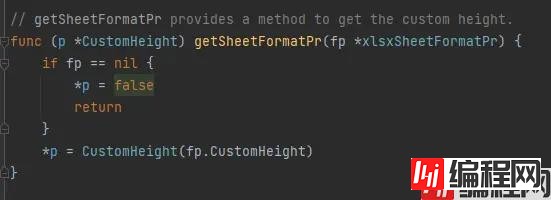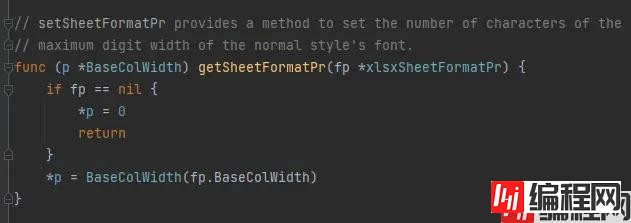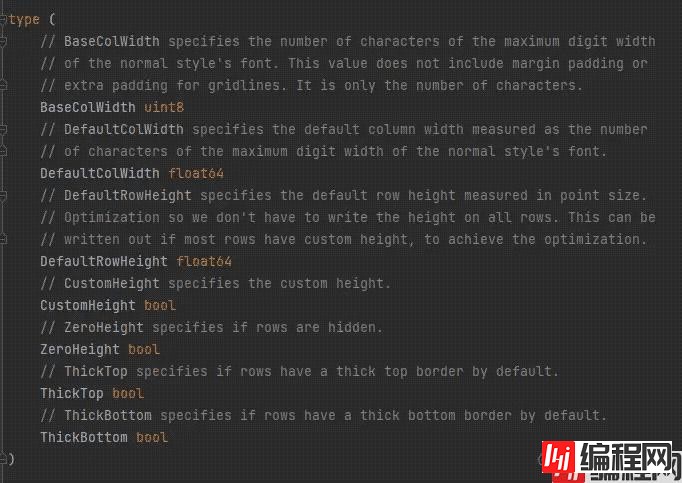目录一、Go-excelize简介二、GetSheetFORMatPr一、Go-Excelize简介 Excelize 是 Go 语言编写的用于操作 Office Excel 文档基
Excelize 是 Go 语言编写的用于操作 Office Excel 文档基础库,基于 ECMA-376,ISO/IEC 29500 国际标准。
可以使用它来读取、写入由 Microsoft Excel™ 2007 及以上版本创建的电子表格文档。
支持 XLAM / XLSM / XLSX / XLTM / XLTX 等多种文档格式,高度兼容带有样式、图片(表)、透视表、切片器等复杂组件的文档,并提供流式读写 api,用于处理包含大规模数据的工作簿。
可应用于各类报表平台、云计算、边缘计算等系统。
使用本类库要求使用的 Go 语言为 1.15 或更高版本。
func (f *File) GetSheetFormatPr(sheet string, opts ...SheetFormatPrOptionsPtr) error
根据给定的工作表名称获取格式属性。
| 可选格式参数 | 数据类型 |
|---|---|
| BaseColWidth | uint8 |
| DefaultColWidth | float64 |
| DefaultRowHeight | float64 |
| CustomHeight | bool |
| ZeroHeight | bool |
| ThickTop | bool |
| ThickBottom | bool |
使用示例:
f := excelize.NewFile()
const sheet = "Sheet1"
var (
baseColWidth excelize.BaseColWidth
defaultColWidth excelize.DefaultColWidth
defaultRowHeight excelize.DefaultRowHeight
customHeight excelize.CustomHeight
zeroHeight excelize.ZeroHeight
thickTop excelize.ThickTop
thickBottom excelize.ThickBottom
)
if err := f.GetSheetFormatPr(sheet,
&baseColWidth,
&defaultColWidth,
&defaultRowHeight,
&customHeight,
&zeroHeight,
&thickTop,
&thickBottom,
); err != nil {
fmt.Println(err)
}
fmt.Println("Defaults:")
fmt.Println("- baseColWidth:", baseColWidth)
fmt.Println("- defaultColWidth:", defaultColWidth)
fmt.Println("- defaultRowHeight:", defaultRowHeight)
fmt.Println("- customHeight:", customHeight)
fmt.Println("- zeroHeight:", zeroHeight)
fmt.Println("- thickTop:", thickTop)
fmt.Println("- thickBottom:", thickBottom)
输出结果:
Defaults:
- baseColWidth: 0
- defaultColWidth: 0
- defaultRowHeight: 15
- customHeight: false
- zeroHeight: false
- thickTop: false
- thickBottom: false
废话少说,上代码:
func (f *File) GetSheetFormatPr(sheet string, opts ...SheetFormatPrOptionsPtr) error {
s, err := f.workSheetReader(sheet)
if err != nil {
return err
}
fp := s.SheetFormatPr
for _, opt := range opts {
opt.getSheetFormatPr(fp)
}
return err
}
代码很简单,先读取工作表,然后获取工作表的格式属性,然后遍历不定长参数opts,对fp的每个opt进行读取。
SheetFormatPrOptionsPtr是一个interface。
type SheetFormatPrOptionsPtr interface {
SheetFormatPrOptions
getSheetFormatPr(formatPr *xlsxSheetFormatPr)
}
该interface 内有两个函数。





我们可以发现,他们都大同小异,第一步的if语句是判断格式属性是否存在,如果不存在就赋一个默认值。 然后取格式属性指针fp的格式属性,前面是类型转换:

type xlsxSheetFormatPr struct {
XMLName xml.Name `xml:"sheetFormatPr"`
BaseColWidth uint8 `xml:"baseColWidth,attr,omitempty"`
DefaultColWidth float64 `xml:"defaultColWidth,attr,omitempty"`
DefaultRowHeight float64 `xml:"defaultRowHeight,attr"`
CustomHeight bool `xml:"customHeight,attr,omitempty"`
ZeroHeight bool `xml:"zeroHeight,attr,omitempty"`
ThickTop bool `xml:"thickTop,attr,omitempty"`
ThickBottom bool `xml:"thickBottom,attr,omitempty"`
OutlineLevelRow uint8 `xml:"outlineLevelRow,attr,omitempty"`
OutlineLevelCol uint8 `xml:"outlineLevelCol,attr,omitempty"`
}
下面介绍一下各个参数的作用:
以上就是Go Excelize API源码解析GetSheetFormatPr使用示例的详细内容,更多关于Go源码解析GetSheetFormatPr的资料请关注编程网其它相关文章!
--结束END--
本文标题: Go Excelize API源码解析GetSheetFormatPr使用示例
本文链接: https://www.lsjlt.com/news/121027.html(转载时请注明来源链接)
有问题或投稿请发送至: 邮箱/279061341@qq.com QQ/279061341
下载Word文档到电脑,方便收藏和打印~
2024-04-05
2024-04-05
2024-04-05
2024-04-04
2024-04-05
2024-04-05
2024-04-05
2024-04-05
2024-04-04
回答
回答
回答
回答
回答
回答
回答
回答
回答
回答
0